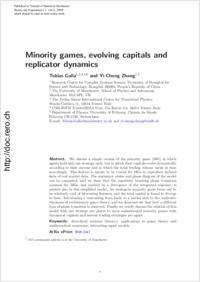Minority games, evolving capitals and replicator dynamics
- Galla, Tobias The University of Manchester, School of Physics and Astronomy, UK - Research Centre for Complex Systems Science, University of Shanghai for Science and Technology, Shanghai, China - The Abdus Salam International Centre for Theoretical Physics, Trieste, Italy - CNR-INFM Trieste-SISSA, Italy
- Zhang, Yi-Cheng Research Centre for Complex Systems Science, University of Shanghai for Science and Technology, Shanghai, China - Department of Physics, University of Fribourg, Switzerland
-
29.11.2009
Published in:
- Journal of Statistical Mechanics: Theory and Experiment. - 2009, vol. 11, p. 11012
interacting agent models
disordered systems (theory)
applications to game theory and mathematical economics
English
We discuss a simple version of the minority game (MG) in which agents hold only one strategy each, but in which their capitals evolve dynamically according to their success and in which the total trading volume varies in time accordingly. This feature is known to be crucial for MGs to reproduce stylized facts of real market data. The stationary states and phase diagram of the model can be computed, and we show that the ergodicity breaking phase transition common for MGs, and marked by a divergence of the integrated response, is present also in this simplified model. An analogous majority game turns out to be relatively void of interesting features, and the total capital is found to diverge in time. Introducing a restraining force leads to a model akin to the replicator dynamics of evolutionary game theory, and we demonstrate that here a different type of phase transition is observed. Finally we briefly discuss the relation of this model with one strategy per player to more sophisticated minority games with dynamical capitals and several trading strategies per agent.
- Faculty
- Faculté des sciences et de médecine
- Department
- Département de Physique
- Language
-
- English
- Classification
- Physics
- License
-
License undefined
- Identifiers
-
- RERO DOC 17448
- DOI 10.1088/1742-5468/2009/11/P11012
- Persistent URL
- https://folia.unifr.ch/unifr/documents/301542
Statistics
Document views: 108
File downloads:
- pdf: 132
